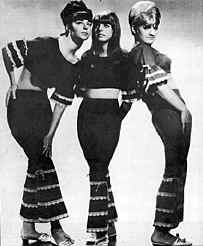
L to R: Mary Aiese, Shelia Reilly and Carol Drobnicki
They never had many hits, but Reparata and the Delrons nonetheless managed a decade long career, consistently recording and touring the world.
Reparata and the Delrons

L to R: Mary Aiese, Shelia Reilly and Carol Drobnicki
They never had many hits, but Reparata and the Delrons nonetheless managed a decade long
career, consistently recording and touring the world.
![]()
| Members (1964-1965) Mary "Reparata" Aiese Carol Drobnicki Sheila Reilly |
(1965-1969) Mary Aiese Nanette Licari Lorraine Mazzola |
(1969-1971) Mary Aiese Nanette Licari Lorraine Mazzola Cookie Sirico |
|
|
|
|
|
|
|
|
The group started out as a five menber high school harmony group called the Delrons, formed in 1962 at St. Brendan's Catholic School in Brooklyn, New York by lead singer Mary Aiese. The other original members included Nanette Licari, Regina Gallagher, and Ann Fitzgerald. They soon would be replaced by Shelia Reilly, Carol Drobnicki and Kathy Romeo. Romeo would be replaced by Marge McGuire who would also leave the group.
Mary was the only original member when the group, now called the Delrons, started up two years later. The new members were Sheila Reilly, Kathy Romeo, and Carol Drobnicki. It was while performing at a high school dance that record producers Steve and Bill Jerome heard them and soon after offerred them a chance to record. They asked Aiese to choose a stage name to make the group name more interesting and marketable. She chose Reparata, her confirmation name, which she had taken from one of her favorite teachers Sister Mary Reparata at Good Shepherd Catholic grammar school.
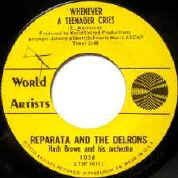
The group, now a trio after the departure of Kathy Romeo, recorded their first single "Your Big Mistake" in 1964 at the World United Studios in New York City for Laurie Records. "Your Big Mistake" proved to be just that as it failed to generate any interests. The Jerome's gave up on Laurie Records and moved the group to Pittsburgh's World Artists Records with Ernie Maresca's song "Whenever a Teenager Cries". The song became a regional hit and reached #60 on the Billboard Hot 100.
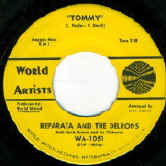
"Whenever A Teenager Cries" entered the Billboard's Pop charts on January 9, 1965, barely missing the Billboard Top 50. Based on the strength of the song they joined Dick Clark's "Caravan of Stars" for a string of one nighters across the country. Meanwhile, they had another minor hit with "Tommy."
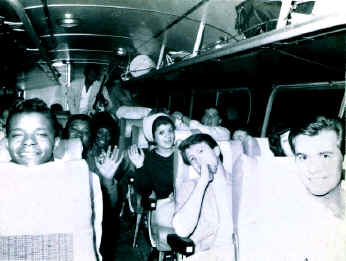
Picture from "Caravan of Stars" tour
Left: Litle Anthony Center: Reparata Right: Dick Clark
The group became more widely known when they were invited to tour nationally with Dick Clark's Caravan of Stars on two occasions during 1965. a ly tour began, and Reparata performed solo on the tour. After tour ended it was discovered that there was no money. Drobicki and Reilly decided they couldn't work for free, dropped out of the group, .Reilly going back to college. On the second leg of the tour tour Reparata performed solo.
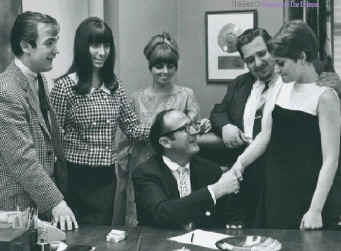
Signing contracts with RCA
(L-R) Lorraine Mazzola, Nanette Licari, Mary Aiese
When Reparata and the Delrons signed with RCA in 1965, new members were needed. Original member Nanette Licari was brought back. "I Can Tell", the first single for RCA needed a third vocalist. Lorraine Mazzola, Reparata asked and agreed to joined the group. This trio of Aiese, Licari, and Mazzola became the group's best-known and most prolific, although they never released an album and none of their dozen singles ever made the US national charts. The group moved again to Mala Records
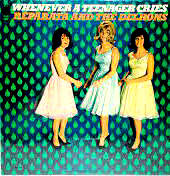
World Artists issued an album Whenever A Teenager Cries which featured their hit and covers of Do Wah Diddy," "If I Fall," "Dedicated To The One I Love," and "Who Do You Love." The liner notes by New York City deejay Johnny Holliday said the "girls" would be taking time off from their studies for the Dick Clark tour and a promotional tour of England.
World Artists issued more of the groups singles including "The Boy I Love," but they failed to chart The Jerome brothers took them to RCA Records and in late 1965 they recorded "I Can Tell." The record featured just Reparata and Nanette Licari, as Carol Drobnicki and Kathy Romero had quit as the group faced another long Dick Clark tour earlier that year.
The group opened for The Rolling Stones at the Philadelphia Convention Hall and Civic Center on their Spring 1965 North American tour.
Reparata, Licari, and Lorainne Mazzola, who had joined the group while they were at RCA, recorded five singles for that label. None charted even though "I Can Hear The Rain" received substantial air play.
|
|
In early 1967 the group moved to Mala a division of Bell Records. Their first record
"I Believe" was a failure. They did better with "Captain Of Your
Ship," a driving rock and roll love song that featured Lorraine Mazzola on lead. It
almost made the billboard charts in the fall of 1967.

1968 on tour in England
(L-R) Mary Aiese, Lorraine Mazzola, Kenny Young, Nanette Licari, Trevor Churchill
While "Captain Of Your Ship" sank in the USA, the record was a hit in England, making the Top 15 in the spring of 1968. The success of the record led to a tour of England in 1968. The group immediately began a three county tour of England, Germany and Poland
In 1969, the group provided backing vocals for The Rolling Stones' single "Honky Tonk Women".
Unable to record any hits the group moved once again. This time they went to Kapp Records in 1969 where they recorded three singles that failed to generate any interest with radio programmers or record buyers.
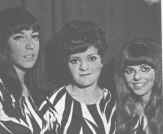
(L-R) Lorraine Mazzola, Mary Aiese, Nanette Licari
In 1969 Mary Aises dropped out of the group, got married,and too concentrate on starting a family. She took her husband's name O'Leary and started a career as a school teacher. She agreed that Lorraine Mazzola and Nanette Licari could carry on without her doing live shows as The Delrons. They recruited Helaine Tobias and with Lorraine Mazzola on lead vocals.
During her time as lead singer Mazzola began to introduce herself a Reparata. Aiese did return briefly to the charts in 1975, again as Reparata, with a minor hit in the USA and England with "Shoes," on the Polydor label.While The Delrons played live shows without her, Mary O'Leary continued to release new Reparata solo singles produced by Steve and Bill Jerome, who had worked on all the group's records since 1964.
In February 1972, Mary O'Leary signed a three-year contract with Dart Records, a UK-based label. Dart quickly released "Octopus's Garden", a cover version of The Beatles song. The recording is credited to Reparata and the Delrons, although only Mary O'Leary is on the recording, not any of the Delrons who were still playing live in the United States at that time.
Live shows stopped in 1973 when Mazzola to become part of Lady Flash Barry Manilow's group. Cooky Sirico and Nanette Licari did not continue with the group after Lorraine Mazzola left, and Reparata and the Delrons went on hiatus as a live act in 1973.
In 1974 Reparata did a remake of the group's 1964 hit "Whenever a Teenager Cries". It was released North American Music Industries label and produced by the Jeromes and arranged by John Abbott.
At this time there was a dispute over the name Reparata. Mary O'Leary had used the name since her confirmation as a teenager, and as her stage name since 1964, first as lead singer of Reparata and the Delrons until 1969, then afterwards as a solo performer. Former bandmate Lorraine Mazzola was now also using the name, having taken over from O'Leary as lead singer at live shows between 1969 and 1973. After this line-up disbanded, Mazzola continued to use the name when working as Barry Manilow's back-up singer, benefiting from the impression that Mazzola had been the lead voice of the still fondly-remembered girl group Reparata and the Delrons.
Mary O'Leary won the right to perform as Reparata so Lorraine Mazzola changed her legal given name from Lorraine to Reparata and therefore she could also continue to use the name. This has continued to cause confusion down the years, with Lorraine Mazzola often assumed to be the person who led the group Reparata and the Delrons throughout its recording career, when in fact all recordings feature Mary O'Leary's lead vocal, except for some tracks on "1970 Rock and Roll Revolution" when all group members took turns singing lead.
In the late 1978 Mary O'Leary asked Nanette Licari and Cokie Sirico to reform the group with her. All three were now in their mid-30s, with jobs outside the music industry: O'Leary was a schoolteacher, Licari a cashier at a Brooklyn department store, and Sirico a secretary at a brokerage stock cage. The group became a part-time project for the trio, and they performed approximately once a month on the oldies circuit, and at club gigs and private functions in the New York City and New England areas for over twenty years.
Nanette Licari left the group in 1987 and was replaced by Lauren Stich.
In the early 1990s, Lauren Stich left the group and returned to her main careers as a horse-racing journalist and handicapper, and as a talent scout. Judy Jae joined Reparata and Cooky Sirico what would be the group's final line-up.
During the 1990s, the group was managed first by Mary O'Leary's husband Jon, then by Vito Picone.
In 2000, Mary O'Leary retired from teaching and decided it was time to also disband the group for good, almost 40 years after she formed the group as a high school student.
Carol Dobnicki died from cancer in December 1980 at the age of 33.